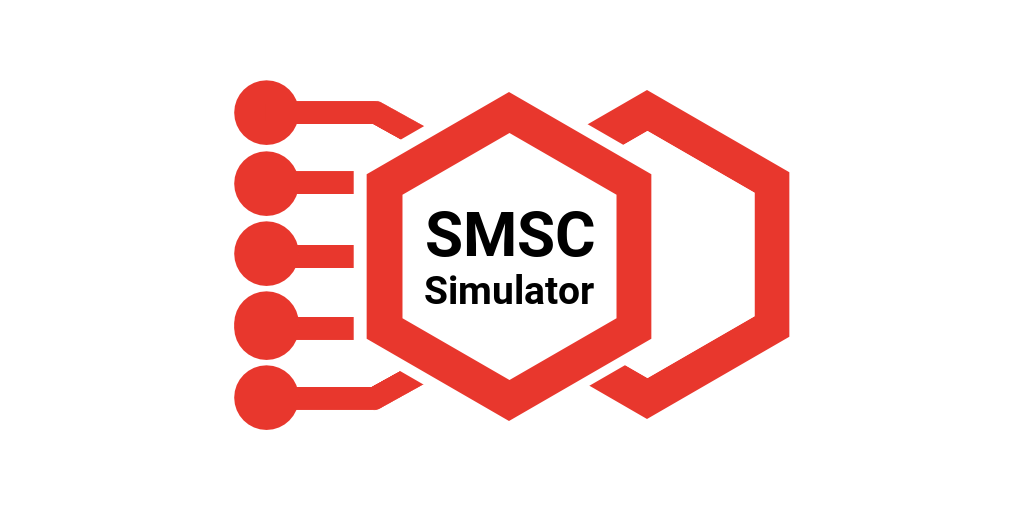SMSC Simulator Technical Details
SMPP SMSC simulator to test SMS messaging applications.

Melrose Labs SMSC Simulator Technical Details Abbreviated SMPP PICS
SMSC Simulator Technical Details Abbreviated SMPP Protocol Implementation Conformance Statement (SMPP PICS)
Operations Supported
| Item | Functional Unit/Description | Supported |
|---|---|---|
| PDU-OUTBIND | Is the outbind PDU supported? | NO |
| PDU-BIND-TRANSMITTER | Is the bind transmitter PDU supported? | YES |
| PDU-BIND-RECEIVER | Is the bind receiver PDU supported? | YES |
| PDU-BIND-TRANSCEIVER | Is the bind transceiver PDU supported? | YES |
| PDU-UNBIND | Is the unbind PDU supported? | YES |
| PDU-ESME-GENERIC-NACK | Is the generic_nack PDU initiated by the EMSE supported? | YES |
| PDU-SMSC-GENERIC-NACK | Is the generic_nack PDU initiated by the SMSC supported? | YES |
| PDU-SUBMIT-SM | Is the submit_sm PDU supported?
| YES
|
| PDU-SUBMIT-MULTI | Is the submit_multi PDU supported? | NO |
| PDU-DELIVER-SM | Is the deliver_sm PDU supported?
| YES |
| PDU-ESME-DATA | Is the data_sm PDU initiated by the EMSE supported?
| YES |
| PDU-SMSC-DATA | Is the data_sm PDU initiated by the SMSC supported?
| YES |
| PDU-QUERY | Is the query_sm PDU supported?
| YES |
| PDU-CANCEL | Is the cancel_sm PDU supported?
| YES
|
| PDU-REPLACE | Is the replace_sm PDU supported? | NO |
| PDU-ESME-ENQUIRE-LINK | Is the enquire_link PDU initiated by the EMSE supported? | YES |
| PDU-SMSC-ENQUIRE-LINK | Is the enquire_link PDU initiated by the SMSC supported? | YES |
| PDU-ALERT | Is the alert_notification PDU supported? | NO |
Operation
Simulate Outbound SMS to to Mobiles
To simulate MT SMS being delivered to a mobile (i.e. outbound SMS or application-to-person SMS) from an application to a mobile, you can use an SMPP TX or TRX bind to submit the MT message to the simulator. The simulator will return a message ID to your application. If a delivery receipt was requested in your submission, a delivery receipt (DLR) will be returned a few seconds later indicating a successful delivery.
Simulate Inbound SMS to your Application
To simulate MO SMS (i.e. inbound SMS or person-to-application SMS) from a mobile to your application, you can either (a) use an SMPP TX bind to submit the MO message to the simulator or (b) use the above Inbound MO SMS Tool.
In either case, you would submit a message using the above SMPP account details to a destination_address that contains the digits of your system ID. By including the digits of your system ID in the destination_address, the message will be routed by the simulator to your application. The destination_address field must be at least 8 digits in length so ensure that you prepend or append at least two digits to your system ID, otherwise the simulator will reject the submission.
Example: If your system ID was "123456" then to send an inbound SMS to your application you would use a separate SMPP transmitter (TX) bind, or the Inbound MO SMS Tool, to submit a message (submit_sm) to the destination_address "99123456" (digits in bold are your system ID). This would cause the SMSC Simulator Technical Details service to send a deliver_sm to your application with the source_addr that you set in the submit_sm and destination_addr of "99123456".
The simulator also supports the use of schedule_delivery_time in the submit_sm and this can be used to schedule delivery of MT and MO SMS.
SMPP operations supported
We are working to ensure that our simulators allow you to test most, if not all, aspects of SMPP applications such as applications with SMS support and SMS infrastructure. Operations currently supported by the simulators are shown below. Further operations will be provided in future and frequent updates.
- Session Management:
- bind_receiver/resp - Used for receiving delivery receipts.
- bind_transmitter/resp - Used for submitting messages.
- bind_transceiver/resp - Supported for v3.4 and v5, and used for submitting messages and receiving delivery receipts.
- unbind/resp - ESME unbinding from SMSC and SMSC issues unbind_resp. SMSC unbinding from ESME when ESME unresponsive.
- enquire_link/resp - Will respond to enquire_link from ESME and will issue enquire_link to ESME every 45s of inactivity.
- Message Submission:
- submit_sm/resp - Will issue positive response with message_id of 8 characters in length for v3.3 and 64 characters for v3.4 and v5. Will issue error response (ESME_INVDSTADR/0x0000000B) if destination_address less than 8 characters in length.
- Message Delivery:
- deliver_sm/resp - Delivery receipts sent to ESME on receiver binds (SMPP v3.3, 3.4 and v5) and transceiver binds (SMPP v3.4 and v5 only). deliver_sm
short_messagefield with textual receipt plus TLVs containing message ID (i.e.receipted_message_id), status of message (i.e.message_statewith value of 2 forDELIVERED) and error (i.e.network_error_codewith value of zero indicating no error)
- deliver_sm/resp - Delivery receipts sent to ESME on receiver binds (SMPP v3.3, 3.4 and v5) and transceiver binds (SMPP v3.4 and v5 only). deliver_sm
Notes on using the SMSC Simulator Technical Details service
- SMPP (Short Message Peer-to-Peer) protocol must be used to connect to the simulator.
- Use SMPP v3.3, v3.4 or v5 and specify the version in the bind request.
- Bind using one or more transmitter (TX), receiver (RX) or transceiver (TRX) binds.
- Use transceiver (TRX) or receiver (RX) binds to receive delivery receipts.
- If a delivery receipt has been requested for a message, a receipt will be returned to your application in <1 second after the submit_sm_resp. If there is no existing TRX or RX bind, then the receipt may be discarded.
- Mobile numbers (MSISDNs) should be in international format.
- TLS 1.1 and up are supported for SMPP sessions. SSL and TLS 1.0 are not supported for connections.
- DeliverSM window size = 25 (default)
Service snapshot
- Test SMS applications and infrastructure without SMS cost
- SMPP v3.3, v3.4 and v5
- MT and MO SMS testing (A2P and P2A)
- SMPP over TCP and SMPP over TLS 1.1+ supported
- SMPP test tool
